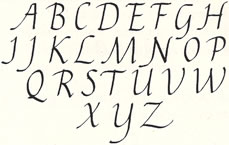Italic Questions and Answers
John Smyth
My experience of teaching italic is with Primary 7 children, aged between 10 and 11 years. The handwriting generally taught in the school is printscript until Primary 5 and then the looped cursive style. I am the only member of staff with expertise in italic and, although I continue, with the majority of the class, to teach the style common to the rest of the school, a number of parents each year ask that their children be taught italic. This is perhaps a somewhat unusual situation, in that a number of children are learning a new style in their fInal Primary year. However, it has proved to be very successful. The 'italic' children by the end of the year are almost invariably able to match the rest of the class in speed and fluency and, indeed, often to outstrip them.
We begin with the correct pen-hold. The pen should be held between the thumb and forefinger and be supported by the middle fInger. It should point on to the paper at an angle of 45°. The middle finger should be supported on the third finger, which rests on the little finger, allowing the side of the hand to sit lightly on the paper. At first the child tends to grip the pen much too tightly. He is encouraged to let his hand relax so that one can draw the pen from between his fmgers without difficulty.
The first exercise is the creation of a single zig-zag pattern thus: The pattern of thicks and thins is pointed out.
At first the child will sometimes make the pattern thus:
Here there is very little difference between thick and thins and this is caused by the nib pointed at the wrong angle.
The italic small-letter alphabet may be divided into family groups of letters, and I teach itas follows: a, d, g, q, c; u, e, o; i, l, t; b, h, k, m, n, r; v, w, y; f, s; p, x, z

A lot oftime is spent studying this letter. Its features are pointed out to the child
- the slight curve forming the 'roof' of the letter
- the graceful, curving stroke down
- the diagonally curving stroke back to the point where one begins.
- The final downward stroke and the open 'wedge' which is a feature of many italic letters.
Common malformations which one gets from children are:

One then deals with the remaining letters of the group.

Please note the angle of the letters, which is a slight slope to the right.
Having to some degree mastered this first group of letters, the children are asked to write each one five times and to tick the best-formed letter of each group. I then have the children discuss the reasons for their choices with me and with each other. My aim is to make them aware of the characteristics of the letter-shapes and to encourage them to assess their work. Two other points about this letter-family are (1) They arc anti-clockwise
letters. (2) d is made with two strokes-thus:  . The other four are one-stroke letters.
. The other four are one-stroke letters.

These are also anti-clockwise letters. Note the open wedge at the bottom of u. The letter o is an oval — not a circle.

The letter t is slightly taller than i. The crossbar of t is used as a horizontal join. l is twice the height of i.

This group consists of clockwise letters. Notice how one's pen branches away from the main stem of the letter in a smooth curve, allowing the open wedge shape to form; m is a particularly graceful letter with its double curve. Beginners sometimes make this letter and the n in too spiky a fashion:

Notice that the first stroke of v and of w is a straight line while the second stroke of v and the third and fourth strokes of w are curved lines.

The crossbar of f acts as a horizontal ligature.
Capitals
Plain Roman capitals written with a slight slope to the right will serve perfectly well. However, I prefer the swash capitals

Joining Letters
The diagonal join is the commonest ligature. It is made with a sideways movement of the pen, allowing the nib to slide upwards on its edge and to make its finest line. Properly made, it will ensure correct spacing between letters. The diagonal join is made from the following letters: a,c,d,e,h,i,k,I,m,n,u. However, there are no inflexible rules about joining. When one's writing becomes more fluent one will find oneself 'doing what comes naturally.'

Examples of using the diagonal join

Examples of using the horizontal join
Speed Writing
It is a prime concem of the teacher that his pupils should be able to write at speed. A beautiful hand is of no use if it cannot cope with the demands made by post-primary education. Practice drills to acquire greater speed are essential. As far as he can the teacher should make these fun to do for the children. I have found that it isn't difficult to hold their interest during the italic lesson. They really enjoy it.
